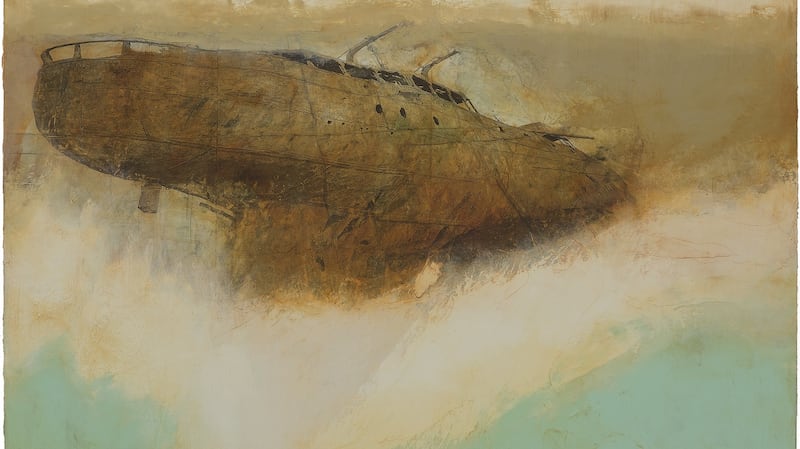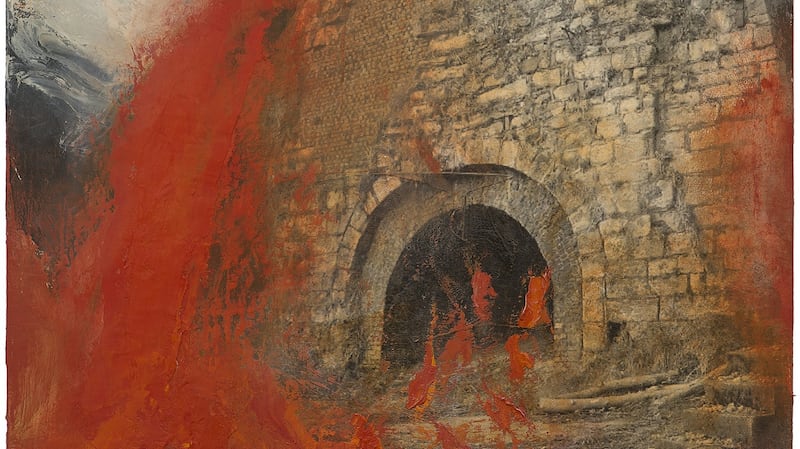Excavations: Hughie O’Donoghue
Oliver Sears Gallery, Dublin
*****


It's been a busy year for Hughie O'Donoghue. One Hundred Years and Four Quarters, the centrepiece visual arts show at the Galway Arts Festival, and The Red Earth, on view at Visual Carlow until the end of January, were overlapping projects on an epic scale. But he's found the energy to make another, related, but distinctive and beautifully judged solo exhibition at Oliver Sears. Excavations comprises two series of work, Shaen's Furnace and Cargo.
The term excavation could be used in relation to practically all of O’Donoghue’s work, not alone because of his copious use of archival, documentary material, much of it steeped in personal, family histories, but also because of the way he works the surface of a painting. It is as though he is unearthing and bringing to light not so much an image, as a mood, an atmosphere, densely packed with layers of memory, reflection and speculation. In being specific, he is not trying to limit the possibilities of interpretation; he is in fact opening them up, finding the universal in the particular.
He is also a fine writer and his texts, as in this case, are not so much about the work as part of it. It touches on sources for both series and makes of them a kind of parable. "The crumbling stones of an old building in a lonely field grew fascinating to me only when I learned that they were the remains of a 17th-century furnace." The furnace was built by Sir Arthur Shaen, who was a landowner in Erris, Co Mayo, the home ground of O'Donoghue's mother's family. It's doubtful the elaborate furnace ever served its purpose, which was to smelt iron. This is hardly surprising in such a harsh setting. Turf proved no substitute for charcoal, and ore was, to put it mildly, scarce.
Something about the hopeless ambition of the project engaged O'Donoghue. There is an echo, perhaps, of the youthful bell-caster in Tarkovsky's Andrei Rublev. The boy does not know how to cast a bell (his father never had a chance to teach him) but sets about doing so anyway, knowing that failure means death. As O'Donoghue writes, "alchemical transformation is an enduring metaphor in art, from Mary Shelley's Frankenstein to Andy Warhol's Brillo Boxes." Some of his furnace paintings incorporate photographic documentation of the structure; others are less specific but in them he clearly relishes the opportunities the imagery affords for an incandescent palette. This from a painter who tends towards the earthy and subdued, but has shown before he can work in quite a different register. There is an inviting freedom to the furnace paintings.
After the fire, the deluge. The Cargo paintings take another rich metaphorical motif, the ship, indeed the wreck. Since O'Donoghue first encountered the wreck of the Plassy on the shore of Inis Oírr as far back as 1962, the vast, rusting hulk has turned up in his work in various guises. A truly monumental treatment, metallic and ghostly, is at the heart of The Red Earth in Carlow. The alchemical promise of transmutation founders on the rocks.
For this latest incarnation of the Plassy, O'Donoghue cites a surprising reference. A figure is visible on deck in Cargo. The artist has in mind Bram Stoker's Dracula, with the Plassy as the Demeter, the ship that carries the vampire and his deadly cargo "out of the past to the new world", as visualised in FW Murneau's film Nosferatu. O'Donoghue is perhaps thinking of the current reemergence of old, corrosive ideas and factional interests, with their roots deep in past enmities and beliefs, at odds with and capable of disrupting and unravelling any tentative progressive gains.
Until January 26th (reopens January 3rd), oliversearsgallery.com
Siobhán Hapaska
Kerlin Gallery, Dublin
*****
With its jagged rhythms and calculated incongruities, Siobhán Hapaska’s recent work at the Kerlin Gallery draws a line under a troubled year. The interruptions and surprises built into the fabric of each piece, whether it is hanging on the wall or a floor-sited sculpture, challenge conventional ideas of wholeness and harmony and coherence. When the surrealist artist André Breton was reading a book by Comte de Lautréamont (the pen name of Isidore-Lucien Ducasse), he leapt on one startling phrase: “As beautiful as the chance encounter of a sewing machine and an umbrella on an operating table.” That, Breton thought, was surrealism.
It could also be Hapaska’s motto. In her work, the Belfast-born sculptor has consistently opted for unorthodox materials yoked together in unexpected ways. In retrospect, it’s tempting to conclude she was influenced, consciously or not, by her early experience of a divided society in a state of conflict. The relationships and interactions between materials and forms that are at the heart of her sculptures reflect disjunctures and inconsistencies in the wider world. The wider world, that is, of relationships of any kind: personal, practical, economic, political.
Such is the case in what is on view at the Kerlin. She seems in this work to be more comfortably in command of her artistic language than ever, which doesn't mean the experience is going to be more comfortable for us as viewers. She doesn't do the rose without the thorns, yet the rose is there: beauty is evident and vital. In Touch, for example, she combines concrete cloth, sturdy oak, acrylic lacquer, plus some steel and aluminium elements, topping off the mixture with synthetic fur. The result is a rollercoaster of sensual impressions and counter-impressions, tough and tender, troubling and reassuring; uneasy but strangely beautiful.
Touch is typical of the several substantial freestanding sculptures. Concrete cloth, an accompanying note explains, is a relatively recent material allowing "for speedy construction" and useful in crisis contexts. Likewise, the polycarbonate sheeting used in the wall pieces is "normally used as lightweight glazing". Here, the wall pieces are more overtly unsettling than the sculptures. The polycarbonate is rendered opaque through the application of "powdered white marble, carbonised oak and pigment" – often red. There is an almost post-apocalyptic feel to the way these sedimentary layers cloud over the glass.
Until February 4 (reopens January 3rd) kerlin.ie

















